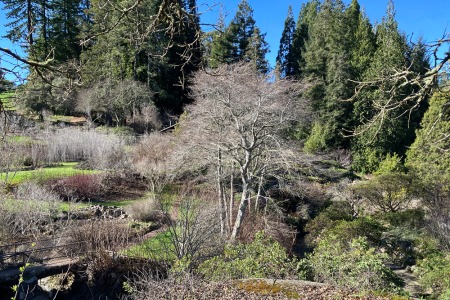
Gene Anderson photo from the Oakwiki, CC SA-BY
The County of Alameda Administration Building at Oak and 12th Streets was designed for work, not for show. Like “Whistler’s Mother,” it’s a study in gray. And at the moment the early-1960s structure looks kind of dingy. But its design lends itself to interesting effects in stone that are apparent at close range.
When it was built, the five-story reinforced-concrete structure was said to embody “contemporary classic” style, and it’s very much of its period. The idea was to add a much-needed annex to the 1930s-era county courthouse across Oak Street — both buildings house courtrooms and are connected by a tunnel — so the Administration Building was meant to complement rather than outshine the earlier structure.

The site is on the gently sloping edge of the downtown platform of ice-age sand dunes. The front entrance on Oak Street serves the ground floor while the rear entrance on Madison serves the second story.
In design and construction, as recorded on the black granite panel on Oak Street, the Admin Building was a local product in a way we don’t see any more.

The architects were an amalgam of designers. Van Bourg, Nakamura and Associates, a young Oakland firm that later became VBN Architects, is responsible for many public buildings in the area. The Berkeley father-and-son team of Walter and Robert Ratcliff added their own gravitas and experience. The construction firm of longtime Alameda resident Ferdinand “Fred” C. Stolte, which had left its mark all over town, handled the building of the building.

It went up relatively fast, easy, and cheap at $4.4 million. The money came from the county employees retirement fund, which the county paid back on good terms.
The design of the Admin Building, first publicized in 1960, included the plaza along Oak Street as we know it today, half trees and half hardscape dotted with massive planters. The walls were clad with precast concrete panels with a “crushed granite finish,” what appears to be polished clasts of dark Sierra granite.

If I’m ever assigned jury duty here, I hope to get a closer look at it and update this post.
To all appearances this is the same kind of cladding used to good effect in the great Kaiser Center edifice and other contemporary buildings, although unlike those cases it’s polished to an even flat face.
Ground was broken for the building on 1 August 1961, and a 3-ton granite cornerstone was laid on 25 September 1962 with a time capsule inside it. The building went up without fuss or undue delay, other than a brief kerfuffle over whether to make the basement level a fallout shelter (they didn’t), a worker strike in 1962 and heavy rains that October.
The dedication took place on 19 March 1964. At the time the trees in the plaza were palms; today they’re plane trees. The Berkeley Gazette called the building “magnificent”; the Tribune noted its “grace and economy of line” although as you can see the context was not particularly about architecture.

This full-page photo caught my eye because the bottom portion shows that the entryway was different, not disabled-friendly, in the early years. It appears that the whole plaza was raised to create today’s level entrance. That would be when the pavement of granite blocks was installed.

The bronze sculpture is not original either; it replaced a fountain that used to drench unwary passers-by on gusty days, leading Supervisor Kent Pursel to complain to the newly formed County Arts Commission in 1966. Another add-on is the white panels flanking the entrance.

These continue inside the lobby. They feature the same high-grade dolomite marble used on the Kaiser Building exterior.

The picture above of the engraved granite slab shows two other attractive features of the Admin Building ground. There’s the rugged pavement of carefully blended crushed stone set in concrete . . .

and the rough-finished panels of luscious blond granite — technically, a syenite — that frame the whole.

I said earlier that the Admin Building is a local product, but this stone is not from around here, or even from California. Probably India or Brazil.
Finally, we have a few boulders in the strip along 11th Street. Plain old clean stones, individuals with personality.

The Sierra Nevada rivers fashioned them, perfect just as they are.
























